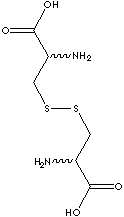|
Amino Acid is any of the organic compounds in which one (or more ) amino group
(-NH2) and one (or more ) carboxylic acid group (-COOH) are both present
with general formula R-CH(NH2)COOH
containing carbon, hydrogen, oxygen, nitrogen, and in certain cases sulfur atoms. Two groups attached to the same carbon
(called the alpha-carbon atom at the end of the compound) are polymerized to form
peptides and proteins. The amine group is protonated to form -NH3+ at low pH. The
carboxylic acid group is deprotonated to form -CO2- at high pH. The carbon atom
in the carboxyl group of one amino acid binds covalently to the nitrogen atom in
the amino group of another amino acid to form a peptide bond with the release of
a water molecule. Proteins are synthesized through the covalent chemical
polypeptide bonds. The sequence of these amino acids in the protein polypeptides
determines the shape, properties, and hence biological role of the protein that
function as chemical messengers and as intermediates in metabolism. Proteins are
composed of various proportions of about 20 commonly occurring amino acids.
Plants or other biological systems can synthesize amino acids from simple
inorganic compounds, but animals rely on adequate supplies in their diet. More
than 100 common amino acids occur in plants or in other microorganic systems.
The 20 amino acids commonly found in animals are Alanine, Arginine, Asparagine,
Aspartic Acid, Cysteine, Glutamic Acid, Glutamine, Glycine, Histidine,
Isoleucine, Leucine, Lysine, Methionine, Phenylalanine, Proline, Serine,
Threonine, Tryptophan, Tyrosine, and Valine. Many of the amino acids can be
synthesized in the human or animal body from other cellular metabolites when needed (called Non-essential Amino
Acids). Animals are not able to synthesize some amino acids necessary in
metabolism in sufficient quantities. It must therefore be present in the diet
(called Essential Amino Acids). In man, these essential amino acids are
Arginine, Histidine, Isoleucine, Leucine, Lysine, Methionine, Phenylalanine,
Threonine, Tryptophan and Valine. Cystine
is a dimer of cysteine with disulphide bridge
which is important in stabilizing the structure of proteins, and in the role of antioxidant. |
